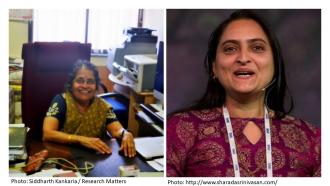Photo: Siddharth Kankaria/ Research Matters
Art and artifacts from yesteryears is of great help to historians and archaeologists to string together stories about the past. They give insights into the culture, religion, politics and other aspects of the society that produced them.
The legacy of erstwhile dynasties of south India survive through the monumental temples they built and metal alloy images they produced. The early historic and medieval sculptures from south India, including that of Nataraja, Buddha, Parvati, Rama and Jaina images made of copper, leaded bronze, brass, and gilt copper, were mostly produced under the patronage of Pallava, Chola, Vijayanagara, Pandya and the Chalukya kings. Would you believe it, if we were to tell you that it is possible to obtain brand new bronze images in the same mould as that of the iconic ones from medieval south India? All it may take is a trip to Swamimalai, a village in Tanjavur district of Tamil Nadu. Sounds intriguing, right? Then read on!
Prof. Sharada Srinivasan is a faculty at the National Institute of Advanced Studies (NIAS), Bengaluru. She has been, all through her career tracing historical artifacts from South India back in time to shed some light on the metallurgical breakthroughs of the period.
In a study published recently, Prof. Srinivasan has analysed the usefulness of lead isotope ratio and compositional analysis in finger-printing and studying the art history of more than 130 sculptures. The study which spanned over two and half a decade established internal consistencies in metallic composition and lead isotope ratio among representative images belonging to the same artistic tradition, thus helping in the diagnosis of images of uncertain attributions.
An interesting fact is that during the study, Prof. Srinivasan found two Nataraja images previously thought to have been from the early Chola period better fitted the lead isotope trends for the images from Pallava period. This indicates that the Nataraja statue, depicting Siva dancing the anandatandava with the lifted leg extended in bhujangatrasita karana, might have been a Pallava rather than a Chola innovation as believed earlier. She also points to probable intriguing ritual connections in its imagery to stellar observances of the Orion constellation. Another prospect the lead isotope investigation offers, is a method to differentiate between Buddhist bronze from Tamil Nadu and Sri Lanka, which is considered a difficult task otherwise. For instance, the study showed that a gilt Buddhist bronze from the Victoria and Albert Museum had trace element trends consistent with a southern Indian attribution of the later Chalukya-Chola period.
“The comparisons of analyses of trace elements of ores and slags from southern India with the copper alloy images seems to rule out the main iron-rich copper source of Seruwila in Sri Lanka as a source of copper in south Indian bronzes. However, the important British Museum gilt image of the Buddhist goddess Tara found in lead-scarce Sri Lanka was found to share its lead source with a Buddha image from Nagapattanam.” Prof. Srininvasan explains. The analysis could also help one locate the source of ores used in casting the images, thus shedding more light into trade relations that existed in the past.
The study uncovered other facts like leaded bronze being widely used for casting antique south Indian images. A preference for brass in ritual artifacts such as lamps over statues were also seen. Although several statues had up to 20% lead and between 8% and 15% tin, which would have facilitated the casting of copper by improving fluidity (which can otherwise result in spongy castings), several of the artistic masterpieces are in fact made of low lead and low tin bronze, indicating the mastery of artisans in making solid castings of such low fluid alloys.
So have we lost this mastery in time? That is where Swamimalai feature in. Sthapathys in Swamimalai, a village in Tanjavur district of Tamil Nadu still follow the lost wax procedure or cire perdue to cast copper-alloy images. In one of her earlier studies, Prof. Srinivasan had undertaken the task of understanding the continuity and changes in casting practises at Swamimalai from that of antiquity. Her new findings indicate that foundry practises haven't changed all that much!
“It is great that the Sthapathis of Swamimalai have diligently nurtured and carried over so many generations the 'lost wax casting' tradition which gave birth to many of the iconic copper alloy images from early historic and medieval South India, involving the making a hollow pattern of the image to be cast in the clay mould by melting out wax, into which the solid metal was cast. However, whereas the majority of medieval south Indian images were well cast bronzes and some brasses, in the present day recourse is made to more heavily chiselling and chasing to finish the images made of a more brassy composition” adds Prof. Srinivasan.
So in some sense, the great legacy of the Chola bronze casting still survives in Swamimalai. In your next trip to Tanjavur or nearby do consider paying Swamimalai and it's rich heritage a visit.
“The importance of such studies also lie in the fact that rather than classifying artefacts by subjective art historical aspects alone, it provides objective technical criteria which not only contribute to the understanding of history of technology, but they can also provide diagnostic tools, ie tracers or finger-prints for bronzes of unknown attribution. In recent times with some of the high profile cases of smuggling of icons, as for example of the Sripuranthan Nataraja, there have been cases where the bronzes have been re-painted to make them look different, so that such technical studies for characterisation and forensic purposes become important,” signs off Prof Srinivasan.






